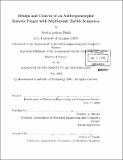Design and control of an anthropomorphic robot finger with multi-point tactile sensation
Author(s)
Banks, Jessica Lauren, 1972-
DownloadFull printable version (6.593Mb)
Alternative title
Anthropomorphic robot finger with multi-point tactile sensation
Other Contributors
Massachusetts Institute of Technology. Dept. of Electrical Engineering and Computer Science.
Advisor
Rodney A. Brooks.
Terms of use
Metadata
Show full item recordAbstract
The goal of this research is to develop the prototype of a tactile sensing platform for anthropomorphic manipulation research. We investigate this problem through the fabrication and simple control of a planar 2-DOF robotic finger inspired by anatomic consistency, self-containment, and adaptability. The robot is equipped with a tactile sensor array based on optical transducer technology whereby localized changes in light intensity within an illuminated foam substrate correspond to the distribution and magnitude of forces applied to the sensor surface plane [58]. The integration of tactile perception is a key component in realizing robotic systems which organically interact with the world. Such natural behavior is characterized by compliant performance that can initiate internal, and respond to external, force application in a dynamic environment. However, most of the current manipulators that support some form of haptic feedback, either solely derive proprioceptive sensation or only limit tactile sensors to the mechanical fingertips. These constraints are due to the technological challenges involved in high resolution, multi-point tactile perception. In this work, however, we take the opposite approach, emphasizing the role of full-finger tactile feedback in the refinement of manual capabilities. To this end, we propose and implement a control framework for sensorimotor coordination analogous to infant-level grasping and fixturing reflexes. This thesis details the mechanisms used to achieve these sensory, actuation, and control objectives, along with the design philosophies and biological influences behind them. The results of behavioral experiments with the tactilely-modulated control scheme are also described. The hope is to integrate the modular finger into an engineered analog of the human hand with a complete haptic system.
Description
Thesis (S.M.)--Massachusetts Institute of Technology, Dept. of Electrical Engineering and Computer Science, 2001. Includes bibliographical references (p. 84-95).
Date issued
2001Department
Massachusetts Institute of Technology. Department of Electrical Engineering and Computer SciencePublisher
Massachusetts Institute of Technology
Keywords
Electrical Engineering and Computer Science.